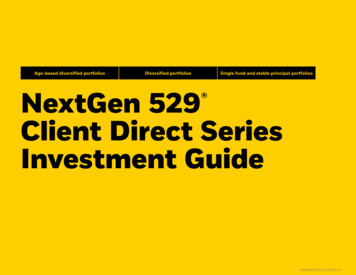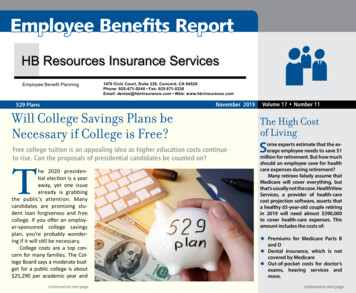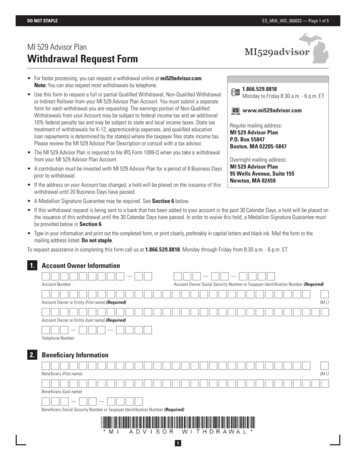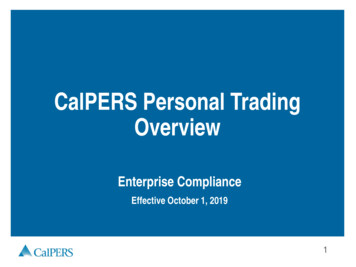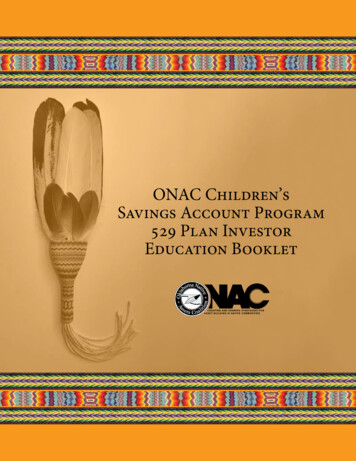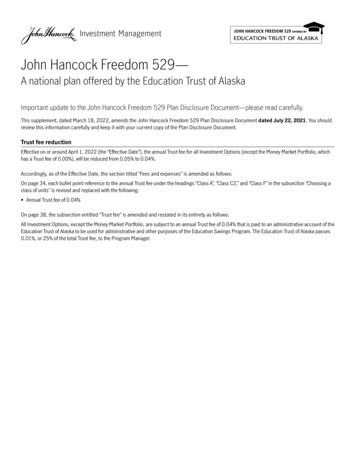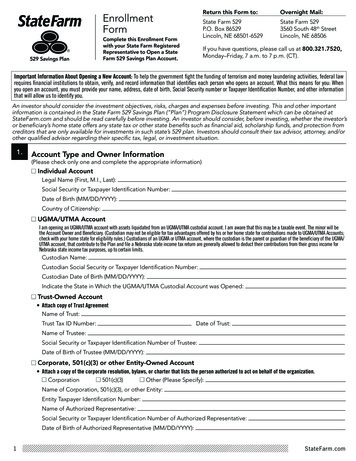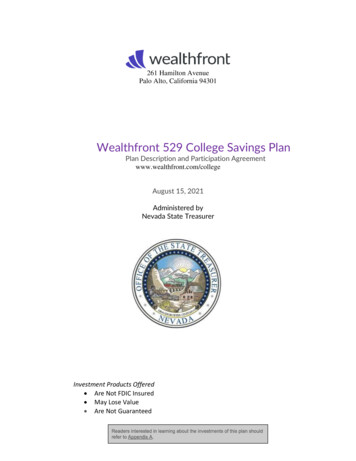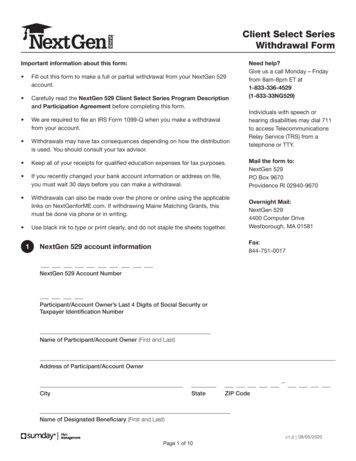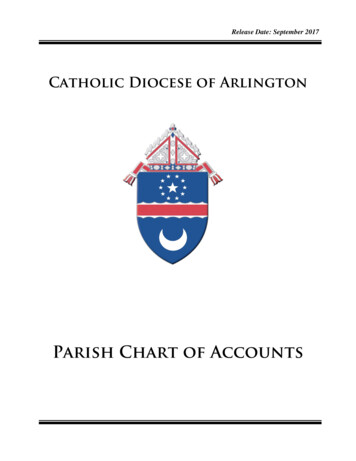
Transcription
Guide to 529 AccountsThe Flexible Way to Invest for CollegeP0218220 02.indd 121/05/2022 05:57
P0218220 02.indd 221/05/2022 05:57
The Most Important Kind ofLong-Term InvestmentWhat is the Return On Investment for a College Education?What is the return on investment for a college education? According to the CollegeBoard, individuals with higher levels of education earn more, pay more taxes, andare more likely than others to be employed.* That’s a good investment by anyone’smeasure, but the costs can be high. The cost of tuition alone for the 2021-2022school year is 38,070 per year for private colleges on average, 27,560 forout-of-state public and 10,740 for in-state public** — and costs continue to risewell beyond the rate of inflation. The good news is that 529 savings accounts arespecially designed to help families make the investment in this most important oflong-term goals.* S ource: College Board Education Pays 2019, The Benefits of Higher Educationfor Individuals and Society.** College Board, Trends in College Pricing and Student Aid 2021.P0218220 02.indd 3221/05/2022 05:57
What is a529 Account?There are many ways for families to save for college — many with federal taxadvantages. But 529 savings accounts are unique because they are set up byindividual states with additional state tax benefits. As long as the investment isused for qualified expenses at an accredited school, the money that is earned iscompletely tax-free. 529s also have an extraordinary degree of flexibility in termsof who can contribute and how much they can contribute.529s vs. Other Education Savings Vehicles529CoverdellESAUGMA/UTMATaxableAccountNo income restrictions High contributions permitted Qualified earnings and withdrawalsare free from federal tax Potential state tax deductions/credits Owner always has control Beneficiary (student) can bechanged at any time NA 3P0218220 02.indd 421/05/2022 05:57
A Special Plan for College PlanningIf you were to design the ideal college savings plan for your children,it would probably have some combination of flexible contribution rules,tax advantages for you, gift and estate tax benefits for grandparentsand other donors, the ability to control the assets and even transfer themto other children, and the right to use it for a wide variety of educationexpenses at most post-secondary schools.All of These Benefits Exist in a 529 Plan. Flexible Contribution Rules — 529 contributions can be made for anyone,by anyone, with high maximums, low minimums and no income restrictions Tax Advantages — 529 plan investments grow tax-deferred, and qualifieddistributions to pay for the beneficiary’s college costs, college loans,apprenticeships or K-12 tuition are free of federal and, in almost all cases,state taxes.1, 2, 3 Your own state may offer additional tax breaks such as anupfront deduction for your contributions Gift Tax Benefits — 529 accounts allow grandparents, friends and familyto contribute the highest amount that can be contributed before incurringgift taxes Estate Planning — 529 accounts are one of the only assets that accountowners can remove from their taxable estate while maintaining controlover the assets Control over Assets — Account owner(s) always controls a 529 account,and can change the beneficiary and even the owner at any time 529 assets can be used for most education expenses including tuition,room and board, books, computers and supplies at most two- and four-yearcolleges, technical, vocational and graduate schools as well as tuition forprimary or secondary public, private and religious schools.41 O nly one state, Alabama, does not offer state tax-free withdrawals for qualified expenses for anyplan but its own. It is important to review local state tax laws before withdrawing from a 529 topay for K-12 tuition, rules surrounding these distributions vary between states. Some states do notconsider these distributions to be qualified and/or may apply additional criteria in order for thedistributions to be considered qualified.2 onqualified withdrawals are subject to a 10% penalty on the earnings component of such withdrawal, Nunless such penalty is waived, as well as taxes at ordinary rates of the recipient on such earnings.States may also charge penalties and/or recoup tax credits/deductions previously claimed.3 O nly the federal tax treatment of expenses for apprenticeships and the repayment of studentloans was changed by the SECURE Act. State taxpayers should be aware that it has not yetbeen determined if states conform to the federal legislation. As a result, it is important for statetaxpayers to consult their tax advisors before (1) making a withdrawal for apprenticeship andstudent loan payments or (2) making a contribution to a 529 plan which they intend to ultimatelywithdraw for apprenticeship or student loan payments. State tax treatment varies by state.Taxpayers who reside or have income in other states should also consult with a qualified taxadvisor before taking any such actions.4 Distributions for tuition in connection with enrollment or attendance at an primary or secondarypublic, private, or religious school are federally income-tax free up to a maximum of 10,000 pertaxable year per beneficiary from all 529 plans. The tax treatment of withdrawals used to payfor primary and secondary school tuition differs between states and as such may differ from thefederal tax treatment as well.P0218220 02.indd 5Did You Know?Financial aid formulas requirea much higher percentage of achild’s assets to be applied towardcollege costs than the parents.529 accounts, unlike many collegesavings arrangements, are typicallyconsidered a parental asset.421/05/2022 05:57
Tax Advantagesto Boost Your College SavingsSaving for college is significantly easier when the earnings used to helppay for education costs grow free from federal — and in most cases state— taxes. This can really make a difference in the amount of money you canaccumulate in the small window of time most parents have to prepare forcollege costs.Federal TaxAdvantagesEstate andGift Tax BenefitsAlthough contributions are notdeductible on your federal taxreturn, your account growsfederally tax-free. You don’t payany tax on withdrawals or earningsas long as the accounts are usedfor qualified education expenses.529s are a great way forgrandparents and other familymembers to create an educationlegacy for a child while shelteringassets from estate and gift taxes.Anyone can make annual tax-freecontributions of up to 16,000( 32,000 for married couples) perchild without incurring gift tax.As an alternative, one can give upto 80,000 ( 160,000 for couples)per child once every five years —all of it free from federal estateand gift taxes.*State Tax AdvantagesAll but one state (Alabama) exemptsqualified 529 withdrawals fromstate tax. In addition, many statesoffer deductions or credits for all orpart of the contribution.5P0218220 02.indd 6* In the event the contributor does not survive the five-year period, a pro-rated amount will revertback to the contributor’s taxable estate.21/05/2022 05:57
The Power of Tax-Exempt GrowthThe cumulative tax savings offered by 529s can really add up over time.The chart below shows how a hypothetical investment of 10,000 thatearned 6% annually over 18 years would have earned 4,450 more in atax-advantaged 529 account than it would in a regular taxable account.Taxable (24% Tax Bracket)Tax-ExemptInitial Investment 10,000Initial Investment 10,000Earnings 14,093Earnings 18,543Future Value(after 18 years) 24,093Future Value(after 18 years) 28,543The tax benefits would multiply if you had invested an additional 150each month for those 18 years. At a 24% tax bracket, the investment wouldgrow to 85,687 in a 529 account compared with 75,298 in a taxableaccount. And that’s before factoring any state or local tax breaks.For illustrative purposes only. Assumed rate of return is not guaranteed. Hypothetical returns do notrepresent any particular products and do not reflect the impact of fees and expenses that may applyto actual investments. Assumes no withdrawals. Investing involves risks and you could incur a profitor a loss.The projected values assume an initial lump sum of 10,000 is invested and 150 is invested eachmonth thereafter for 18 years at a hypothetical compound annual growth rate of 6%, accruedmonthly, and a 24% federal tax bracket.P0218220 02.indd 7621/05/2022 05:57
Choosing theRight 529 Plan for Your NeedsThere are many different 529 plans to choose from, so it’s easy to select the planthat’s right for your family’s budget and needs. You’ve taken a good first stepby working with a financial professional. Financial professionals can reduce thecomplexity of financial markets to focus on your goals and how best to reach them.What to Look For: Consider your own state firstYou’re not required to invest in yourown state’s plan, but it’s usually thebest place to start looking, since moststates offer at least some state taxbenefits to their own 529 investors.However, be sure these advantages arenot outweighed by lower investmentperformance, higher fees and accountrestrictions. Look for flexibility in investmentsFamilies have different needs when itcomes to investing, so it’s importantthat a range of options are available.Some of the more common includeage-based (where allocations changeas the beneficiary approaches college),risk-based, a diversified mix of funds,and selections from more than oneinvestment manager. Look for convenient services Look at costLike all investment programs, 529 planshave costs, which can affect long-terminvestment results. While cost isn’t theonly consideration in deciding on a 529plan, it may be helpful to look at costswhen comparing similar plans. Look for joint ownershipMany couples make joint financialdecisions, and joint ownership allowseither party to make investment,funding and withdrawal decisions forthe student. Consider plans that allow rolloversMany plans allow you to rollexisting assets currently in a Trust,a UGMA/UTMA, U.S. Savings Bonds,or a Coverdell Education IRAinto a 529 account to take advantageof its education saving benefits.Busy families don’t want to haveto turn a 529 plan into homework.Make sure your plan offers time-savingfeatures like web access, automaticinvestment programs and collegeplanning tools.7P0218220 02.indd 821/05/2022 05:57
Did You Know?A total 215,064 loan* at 8% wouldcost 195,891 more over ten years thanif you made monthly 529 paymentsinstead of taking a loan.* Amount is calculated to cover 25,000 annual costof college over four years. The example assumesmonthly loan payments of 2,609 to pay downthe 313,118 loan, which includes interest paidof 98,054, vs. monthly 529 account contributionsof 465 totalling 117,228 and earning an assumed6% rate of return.It Takesa Family to Pay for College Parents can set aside monthly or annual contributions when the child is born Grandparents, aunts and uncles can give gifts at birthdays, holidays and graduations Extended family can help with the lifetime gift of education Friends can contribute the same amount as family Beneficiaries can contribute from summer jobs or gifts8P0218220 02.indd 921/05/2022 05:57
Putting It All TogetherEstablishing a 529 college savings account is a great way to meet one of life’sbiggest investment objectives. With a little advance planning — and the assistanceof your financial professional — you can quickly and easily put your family on theright track to making college possible.Working with Your Financial Professional Step-by-Step1Determine Funding NeedsLook at the type of colleges you think would be appropriate and look at their currentcosts — tuition, room and board, books, fees. Factor in approximately 1.6% a year forcollege cost beyond inflation (average annual percentage increase in inflation-adjustedpublished prices for the past 10 years).*Contribution Resources2 DetermineLook at how much you can invest initially, including contributions from grandparents,extended family and friends. Then calculate how much you can set aside monthly orquarterly. Chances are your financial professional can help you select investments thatwork within these financial parameters.a 529 Plan and Open an Account3 SelectChoosing a 529 plan is the hard part, since there are so many from which to choose.Your financial professional can be an invaluable resource in identifying the plan that’sclosest to your objectives.9P0218220 02.indd 10* College Board, Trends in College Pricing and Student Aid 2021.21/05/2022 05:57
P0218220 02.indd 1121/05/2022 05:57
An investor’s or a designated beneficiary’s home state may offer state tax or other state benefits such as financial aid, scholarship funds, and protection from creditors thatare only available for investments in that state’s qualified tuition program. Please consider this before investing.Earnings component of non-qualified withdrawals may be subject to federal and state taxes and the additional federal 10% tax.Investments in 529 Plans are subject to certain charges, which will reduce the value of your account as they are incurred. Please see the Program Description or other disclosuredocument for details of charges or fees that apply to your 529 Plan.Investments in 529 plans are not guaranteed or insured and are subject to investment risks, including the loss of the principal amount invested.The tax information herein is not intended to be used, and cannot be used by any taxpayer, for the purpose of avoiding tax penalties. Taxpayers should seek advice based ontheir own particular circumstances from an independent tax advisor.Investors should carefully consider the investment objectives, risks and charges and expenses of 529 plans and their underlying funds before investing.This and other information can be found in the Program Description or other disclosure documents of the 529 Plan. You may obtain this information fromthe programs’ administrators or your financial professional. Please read this information carefully before investing or sending money.BSIG-529 051822 IM2209101 168209 WLTP0218220 2022 Voya Investments Distributor, LLC 230 Park Ave, New York, NY 10169 All rights reserved.(800) 992-0180 Individual Investors (800) 334-3444 Investment Professionalsvoyainvestments.comP0218220 02.indd 1221/05/2022 05:57
to turn a 529 plan into homework. Make sure your plan offers time-saving features like web access, automatic investment programs and college planning tools. Look at cost Like all investment programs, 529 plans have costs, which can affect long-term investment results. While cost isn't the only consideration in deciding on a 529
